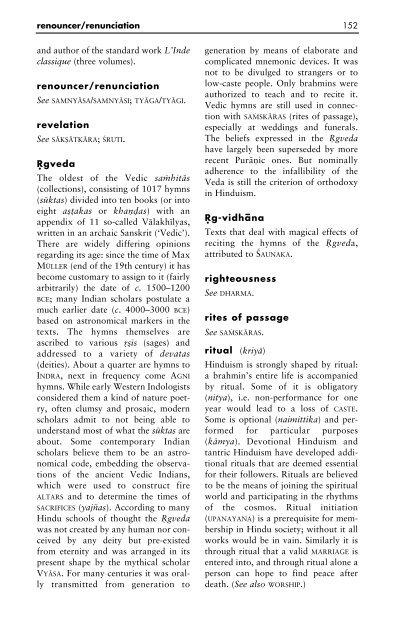A Concise Encyclopedia of Hinduism Klaus K Klostermaie
You also want an ePaper? Increase the reach of your titles
YUMPU automatically turns print PDFs into web optimized ePapers that Google loves.
enouncer/renunciation 152<br />
and author <strong>of</strong> the standard work L’Inde<br />
classique (three volumes).<br />
renouncer/renunciation<br />
See SAMNYÄSA/SAMNYÄSI; TYÄGA/TYÄGI.<br />
revelation<br />
See SÄKÆÄTKÄRA; ŸRUTI.<br />
Øgveda<br />
The oldest <strong>of</strong> the Vedic saƒhitäs<br />
(collections), consisting <strong>of</strong> 1017 hymns<br />
(süktas) divided into ten books (or into<br />
eight a•flakas or khaæõas) with an<br />
appendix <strong>of</strong> 11 so-called Välakhïlyas,<br />
written in an archaic Sanskrit (‘Vedic’).<br />
There are widely differing opinions<br />
regarding its age: since the time <strong>of</strong> Max<br />
MÜLLER (end <strong>of</strong> the 19th century) it has<br />
become customary to assign to it (fairly<br />
arbitrarily) the date <strong>of</strong> c. 1500–1200<br />
BCE; many Indian scholars postulate a<br />
much earlier date (c. 4000–3000 BCE)<br />
based on astronomical markers in the<br />
texts. The hymns themselves are<br />
ascribed to various ø•is (sages) and<br />
addressed to a variety <strong>of</strong> devatas<br />
(deities). About a quarter are hymns to<br />
INDRA, next in frequency come AGNI<br />
hymns. While early Western Indologists<br />
considered them a kind <strong>of</strong> nature poetry,<br />
<strong>of</strong>ten clumsy and prosaic, modern<br />
scholars admit to not being able to<br />
understand most <strong>of</strong> what the süktas are<br />
about. Some contemporary Indian<br />
scholars believe them to be an astronomical<br />
code, embedding the observations<br />
<strong>of</strong> the ancient Vedic Indians,<br />
which were used to construct fire<br />
ALTARS and to determine the times <strong>of</strong><br />
SACRIFICES (yajñas). According to many<br />
Hindu schools <strong>of</strong> thought the Øgveda<br />
was not created by any human nor conceived<br />
by any deity but pre-existed<br />
from eternity and was arranged in its<br />
present shape by the mythical scholar<br />
VYÄSA. For many centuries it was orally<br />
transmitted from generation to<br />
generation by means <strong>of</strong> elaborate and<br />
complicated mnemonic devices. It was<br />
not to be divulged to strangers or to<br />
low-caste people. Only brahmins were<br />
authorized to teach and to recite it.<br />
Vedic hymns are still used in connection<br />
with SAßSKÄRAS (rites <strong>of</strong> passage),<br />
especially at weddings and funerals.<br />
The beliefs expressed in the Øgveda<br />
have largely been superseded by more<br />
recent Puräæic ones. But nominally<br />
adherence to the infallibility <strong>of</strong> the<br />
Veda is still the criterion <strong>of</strong> orthodoxy<br />
in <strong>Hinduism</strong>.<br />
Øg-vidhäna<br />
Texts that deal with magical effects <strong>of</strong><br />
reciting the hymns <strong>of</strong> the Øgveda,<br />
attributed to ŸAUNAKA.<br />
righteousness<br />
See DHARMA.<br />
rites <strong>of</strong> passage<br />
See SAßSKÄRAS.<br />
ritual (kriyä)<br />
<strong>Hinduism</strong> is strongly shaped by ritual:<br />
a brahmin’s entire life is accompanied<br />
by ritual. Some <strong>of</strong> it is obligatory<br />
(nitya), i.e. non-performance for one<br />
year would lead to a loss <strong>of</strong> CASTE.<br />
Some is optional (naimittika) and performed<br />
for particular purposes<br />
(kämya). Devotional <strong>Hinduism</strong> and<br />
tantric <strong>Hinduism</strong> have developed additional<br />
rituals that are deemed essential<br />
for their followers. Rituals are believed<br />
to be the means <strong>of</strong> joining the spiritual<br />
world and participating in the rhythms<br />
<strong>of</strong> the cosmos. Ritual initiation<br />
(UPANAYANA) is a prerequisite for membership<br />
in Hindu society; without it all<br />
works would be in vain. Similarly it is<br />
through ritual that a valid MARRIAGE is<br />
entered into, and through ritual alone a<br />
person can hope to find peace after<br />
death. (See also WORSHIP.)


















